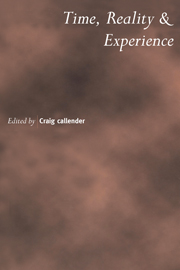Book contents
- Frontmatter
- Contents
- Preface
- Notes on Contributors
- When Time Gets Off Track
- Burbury's Last Case: The Mystery of the Entropic Arrow
- Zeno's Arrow and the Significance of the Present
- Presentism, Ontology and Temporal Experience
- A Presentist's Refutation of Mellor's McTaggart
- Time and Degrees of Existence: A Theory of ‘Degree Presentism’
- McTaggart and the Truth about Time
- On Absolute Becoming and the Myth of Passage
- Time Travel and Modern Physics
- Freedom from the Inside Out
- On Stages, Worms and Relativity
- On Becoming, Cosmic Time and Rotating Universes
- How Relativity Contradicts Presentism
- Can Physics Coherently Deny the Reality of Time?
- Rememberances, Mementos, and Time-Capsules
Rememberances, Mementos, and Time-Capsules
Published online by Cambridge University Press: 05 May 2010
- Frontmatter
- Contents
- Preface
- Notes on Contributors
- When Time Gets Off Track
- Burbury's Last Case: The Mystery of the Entropic Arrow
- Zeno's Arrow and the Significance of the Present
- Presentism, Ontology and Temporal Experience
- A Presentist's Refutation of Mellor's McTaggart
- Time and Degrees of Existence: A Theory of ‘Degree Presentism’
- McTaggart and the Truth about Time
- On Absolute Becoming and the Myth of Passage
- Time Travel and Modern Physics
- Freedom from the Inside Out
- On Stages, Worms and Relativity
- On Becoming, Cosmic Time and Rotating Universes
- How Relativity Contradicts Presentism
- Can Physics Coherently Deny the Reality of Time?
- Rememberances, Mementos, and Time-Capsules
Summary
Time Capsules and Presentism
I want to consider some features of the position put forward by Julian Barbour in The End of Time that seem to me of particular philosophical interest. At the level of generality at which I'll be concerned with it, the view is relatively easy to describe. It can be arrived at by thinking of time as decomposing in some natural way linearly ordered atomic parts, ‘moments’, and combining an observation about the internal structure of moments with an epistemological doctrine about our access to the past. The epistemological doctrine, which I'll call ‘Presentism’, following Butterfield, is the view that our access to the past is mediated by records, or local representations, of it. The observation is that the state of the world at any moment has the structure of what Barbour calls a ‘time capsule’, which is to say that it constitutes a partial record of its past, it is pregnant with interrelated mutually consistent representations of its own history.
When he speaks of time capsules, Barbour has in mind things like tracks formed in a cloud chamber when a decaying nucleus emits an α-particle, footsteps in the sand made by a passerby, or fossil records of prehistoric animals. But to get a grip on what time capsules look like in cases that approach realistic complexity, you should think of something like Proust's Rememberance of Things Past conceived not as an historical novel, but as a description of the intrinsic structure of a single moment.
- Type
- Chapter
- Information
- Time, Reality and Experience , pp. 317 - 328Publisher: Cambridge University PressPrint publication year: 2002
- 3
- Cited by

